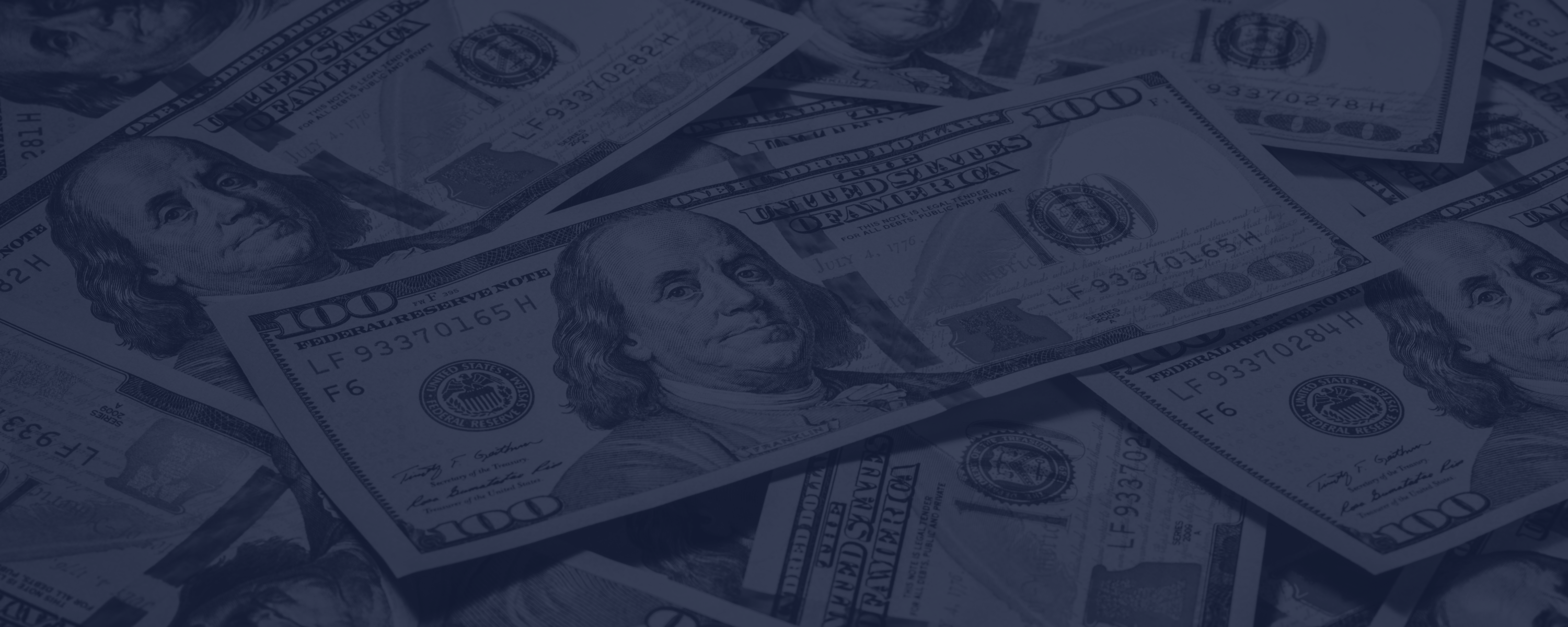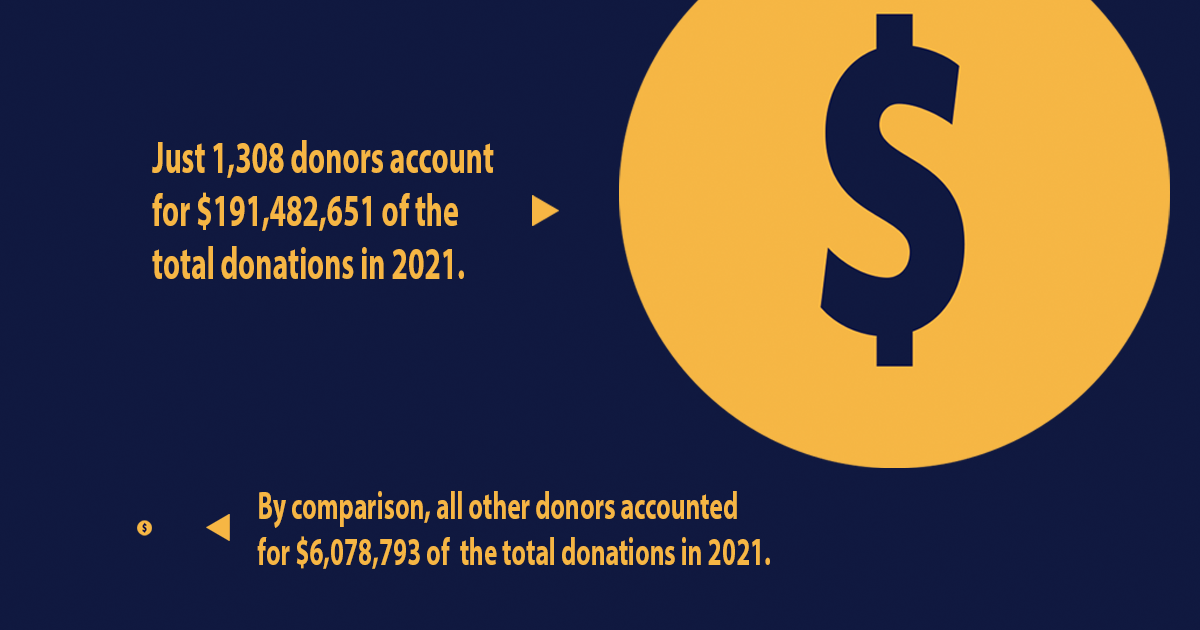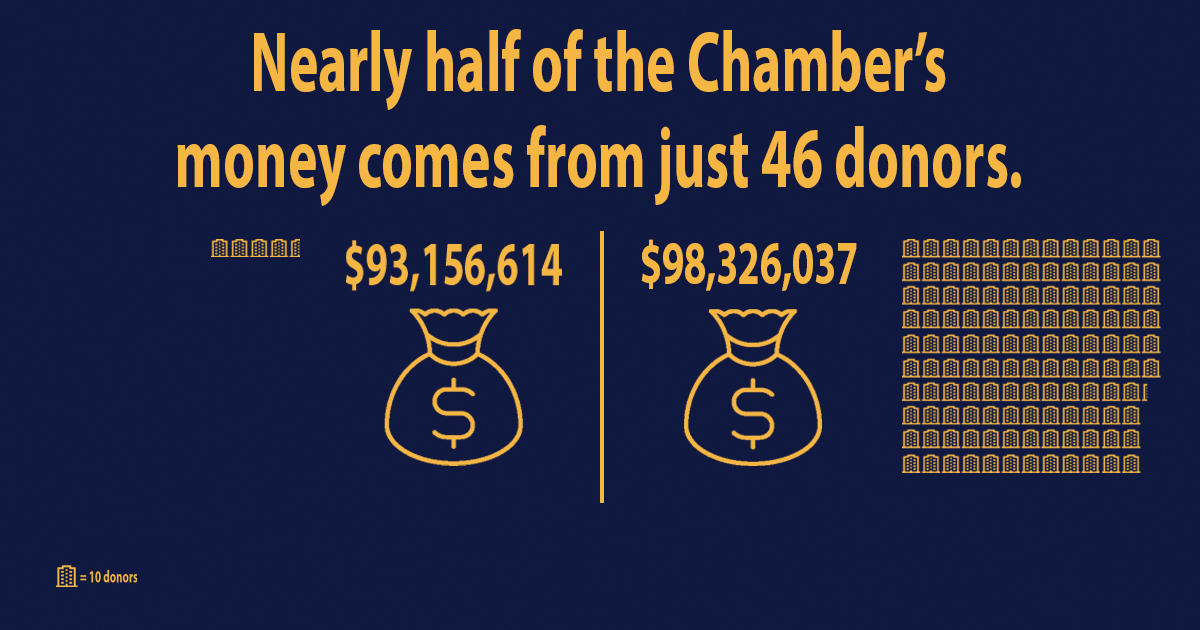
The Interests of the Few
How the Chamber’s Lopsided Donor Base Mirrors its Advocacy
By Zachary Brown
The U.S. Chamber of Commerce (hereinafter, “the Chamber”) routinely posits itself as the true representative of the business community, boasting a diverse membership ranging from the largest of corporate conglomerates to small local businesses. In fact, the Chamber boldly claims to represent the interests of over 3 million businesses across the country.
And while the Chamber is well known for claiming this broad range of support it is also well known for refusing to disclose the identities of donors. In fact, the Chamber has been one of the leading opponents of proposal to require disclosure of donors to groups that engage in political activities.
However, the Chamber is legally required to provide members of the public with tax forms that include the itemized amounts of all contributions it receives of $5,000 or more. (The Chamber is permitted to redact the identities of these donors, and it did so in forms it provided to Public Citizen.) For the purpose of this report, we consider contributions of at least $5,000 to be “large” contributions.
The Chamber’s tax forms for the calendar year 2021 indicate that it received 97 percent of its contributions from about 1,300 contributors and nearly 50 percent of its money from just 46 donors. The narrow donor base casts serious doubts on the Chamber’s claims that it represents such a broad range of business. Organizations usually serve the wishes of those that provide them with income.
Instead, this donor profile suggests that the Chamber is receiving the overwhelming share of its donations from large businesses. Most small businesses would likely not be able to afford to donate $146,000 (about the average size of the itemized contributions reported by the Chamber) to a trade association. And even if all the itemized contributions were from small businesses, 1,308 donors amount to only a paltry 0.04% of the over 3 million entities that the Chamber claims to represent. Whoever the Chamber is truly working for, it’s receiving almost all of its money from a tiny slice of U.S. businesses, assuming its donors are businesses.
For this study, we reviewed the Chamber’s recent advocacy over the last five years. And upon analysis of the Chamber’s advocacy positions, the Chamber’s actions seemingly exist in concert with the makeup of its donor base.
If the Chamber were truly advocating for the interests of three million businesses, considering the diverse needs of businesses both large and small, there are a variety of changes the organization could implement. We provide a few of these recommendations at the end of this report.
The Overwhelming Majority of the Chamber’s Contributions Come From Large Donors

First, the Chamber’s funding profile puts into question its position as a representative of 3 million businesses because its funding is made up predominantly of large donations. [See Table 1]
Of the nearly $198 million that make up the Chamber’s total 2021 contributions, 97 percent of its contributions came from donors giving at least $5,000, that is, “large donors.” This greatly undershoots the size of its actual itemized contributions, which average about $146,000.
Table 1: 97% of the Chamber’s Contributions Come From Itemized Contributions More Than $5,000
| Total $ of Chamber Contributions Reported | Total $ of Itemized Contributions | Total # of Itemized Contributions | Avg. Donation $ | % Of Chamber Contributions from Itemized Contributions over $5,000 |
| $197,461,444 | $191,482,651 | 1,308 | $146,393 | 97.0% |
Source: U.S. Chamber of Commerce Form 990, 2021
Non-itemized contributions, i.e., those below $5,000, accounted for about $6 million, making up only 3 percent of the Chamber’s contributions. [See Table 2]
Table 2: The 3 Million Businesses the Chamber Claims To Represent Only Make Up 3% of the Chamber’s Total Contributions
| Connection to Chamber | Number | Total Contributions | Average Donation | % of Total Contributions |
| Large Donor | 1,308 | $191,482,651 | $146,393 | 97.0% |
| Businesses Whose Interests Chamber Claims to Represent | 3,000,000 | $6,078,793 | $2.03 | 3.0% |
Source: U.S. Chamber of Commerce Form 990, 2021
II. The Chamber Receives 80% of Its Large Donor Money From Those Who Give More Than the Average Amount
Even within the tiny fraction of donors who account for most of its contributions, the donor profile is extremely top heavy.
Only 234 donors gave more than the average. They accounted for more than 80 percent of the Chamber’s total itemized contributions. [See Table 3]
Table 3: The 234 Entitites Who Gave More Than the Average Donation Made Up 82.8% of the Chamber’s Itemized Contributions
| Donor Type | # of Donors | % of Total Itemized Donors | $ | % of Total Itemized Contributions |
| Gave more than $146,393 | 234 | 17.9% | $158,607,853 | 82.8% |
| Gave less than $146,393 | 1,074 | 82.1% | $32,874,798 | 17.2% |
Source: U.S. Chamber of Commerce Form 990, 2021
III. Nearly Half of the Chamber’s Money Came From 46 Donors That Gave $1 Million or More

Looking at the top of the itemized contributions reveals an even more shocking reality. Nearly half of the Chamber’s money comes from just 46 donors all giving at least a million dollars. [See Table 4 and Appendix]
The lopsided nature of the Chamber’s contributions is illustrated across various donor ranges in both table and bar chart form in the Appendix.
Table 4: Just 46 Donors Gave More Than Half of the Chamber’s Total Itemized Contributions
| Donation Range | # of Donors | Sum of Contributions | % of Itemized Donors | % of Total Itemized Contributions |
| At least $1,000,000 | 46 | $93,156,614 | 3.5% | 48.7% |
| Less than $1,000,000 | 1262 | $98,326,037 | 96.5% | 51.3% |
Source: U.S. Chamber of Commerce Form 990, 2021
IV. A Select Few Donors at the Top of the Donor Pool Gave More Than a Quarter of the Chamber’s Money
Moving on to the very top of the Chamber’s donor base reveals an even more startling picture. The top 1.4 percent of donors provided more than a quarter of the Chamber’s itemized contributions. [See Table 5]
Table 5: Donors Who Gave More Than $2 Million Gave More than a Quarter of the Chamber’s Contributions
| Donation Range | # of Donors | Average Donation | % of Itemized Donors | Total Donations | % of all itemized contributions in dollar value |
| >$4 million | 3 | $5,487,047 | 0.2% | $16,461,142 | 8.6% |
| $2 million to < $4 million | 15 | $2,507,464 | 1.1% | $37,611,965
|
19.0% |
| Total | 18 | $3,004,062 | 1.4% | $54,073,107 | 28.2% |
Source: U.S. Chamber of Commerce Form 990, 2021
V. Just Three Donors Gave More Than Eight Percent of the Chamber’s Money
Lastly, the top three donors provided 8.3% of the Chamber’s contributions. [See Table 6 below] We believe it’s reasonable to assume that these 3 mystery donors wield a significant influence on the Chamber’s actions and activities.
Table 6: Donors Who Gave More Than $4 Million Gave 8.3% of the Chamber’s Contributions
| Donation Range | # of Donors | Average Donation | % of Itemized Donors | Total Donations |
| >$4 million | 3 | $5,487,047 | 0.2% | $16,461,142 |
Source: U.S. Chamber of Commerce Form 990, 2021
VI. The Chamber’s Advocacy Matches Its Funding Profile
Tax disclosures strongly suggest that the organization is funded and influenced by the largest corporate bodies in America. Why is that a problem? Because of the very positions and policy goals that the Chamber advocates for on a regular basis.
For one, the Chamber regularly advocates against actions by federal agencies such as the Consumer Financial Protection Bureau (CFPB) designed to protect consumer’s financial interests. Recently, the Chamber has joined a challenge to the CFPB’s funding model. Dismantling the CFPB would aid large businesses engaging in predatory practices such as padding their incomes by slapping junk fees on ordinary Americans.
Additionally, the Chamber advocates on behalf of large corporations against the potential federal ban on noncompete clauses in labor contracts. While noncompete clauses are also used by some small businesses, their inclusion into labor contracts is relatively common practice within the largest corporations in America. Noncompete clauses not only decrease market competition (further aiding longstanding corporate conglomerates), but make it more difficult for potential entrepreneurs to begin new businesses as the potential workforce decreases.
The Chamber also advocates for the interests of large businesses by regularly fighting against proposed increased anti-trust provisions to stop harmful corporate mergers. Large corporate mergers that hurt competition directly affect the survival of everyday small businesses. After all, federal agencies such as the FTC only come into play to enforce mergers when the transaction is more than $100 million, a far cry from the general financial affairs of smaller businesses across the nation.
The Chamber also routinely advocates for the interests of large fossil fuel companies, in so doing failing to pay heed to the increasing adversity that climate change is already causing businesses across the country.
While large businesses may have the financial resources to recover from increasingly destructive climate calamities, small businesses may have proportionally larger financial impacts that could damage the health of the company.
The best businesses plan for the long-term, and their representatives should do the same. If the Chamber did so, it would realize that climate change is a significant threat to its donor base, their own organization, and the larger public as a whole.
The lopsided nature of the Chamber’s advocacy mirrors the lopsided nature of their donor pool.
VII. A Few Recommendations for the Chamber
The Chamber claims to represent the interests of 3 million businesses, however here are a few recommendations for how it could better broaden its scope to truly represent that broad swath of the economy.
- The Chamber should begin freely disclosing the identity of its donors. Added transparency would not only add to the legitimacy of the organization, but also add an additional layer of accountability for the Chamber’s advocacy actions on behalf of 3 million businesses nationwide. And of course, if their decisions are truly being made in the best interest of the broader business community, it will only help them grow as an association to be recognized as such.
- The Chamber’s advocacy on behalf of environmentally harmful legacy industries such as the fossil fuel industry directly impacts the future health and prosperity of businesses nationwide. Supporting long-term projects such as the Keystone XL pipeline, which would solidify our nation’s reliance on fossil fuels, moves the nation backwards regarding a shift to renewable energies. Fully leaning into the movement to transition corporate America to utilize clean, renewable energy sources could go a long way towards helping the full gamut of businesses the Chamber claims to represent.
- The Chamber should reverse course and begin encouraging more thorough and robust antitrust enforcement. It is inconsistent with the Chamber’s claims to represent such a large group of business interests to fight against mechanisms that would enhance competition. Small business is well-served by a more competitive marketplace.
- Lastly, the Chamber should focus its efforts overall on policies and actions that benefit the whole of the business landscape, rather than just the largest corporations. Legislative and rulemaking that may benefit a small subset of mega-companies while harming the overall business landscape should not be advocated for by the organization.
After all, the Chamber’s mission statement claims “For all of the people across the businesses we represent, the U.S. Chamber of Commerce is a trusted advocate, partner, and network, helping them improve society and people’s lives.”
It’s time for the Chamber’s actions to match its mission.